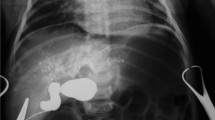Abstract
Our aim was to evaluate the efficacy of ultrasonographic (US) examination in the pre-operative diagnosis of biliary atresia (BA) with special reference to the presence or absence of extrahepatic bile duct. Thirty consecutive neonates and infants aged 8 to 169 days (mean: 62 days) suspected of having biliary atresia were examined pre-operatively in real time B-mode ultrasonography. We used a 5 or 7.5 MHz probe of micro convex type. Patients were fasted and sedatives administered. When the common bile duct was absent, we considered it a positive finding for BA diagnosis; if not, it was considered a negative finding. A definitive diagnosis of BA was confirmed at surgery by gross morphology or intra-operative cholangiography. US findings had a sensitivity of 83% (19 of 23 BA patients), a specificity of 71% (5% of 7 non BA patients) and an accuracy rate of 80%. The positive predictive value was 90% (19 of 21), while the negative predictive value was 56% (5 of 9). There were four false-negative cases. Two were BA cases with patent distal common bile duct, one was BA in which the hepatic artery was determined to be the common bile duct, and the other was a subtype of extrahepatic bile duct dilatation (the so-called, "correctable type"). We employed US criteria for visualization of the extrahepatic bile duct for pre-operative diagnosis of BA. US examination referring to the presence or absence of the extrahepatic bile duct is an effective and useful method for clinical survey.


Similar content being viewed by others
References
Abramson SJ, Treves S, Teele RL (1982) The infant with possible biliary atresia. Evaluation by ultrasound and nuclear medicine. Pediatr Radiol 12:1–5
Choi SO, Park WH, Lee HJ, Woo SK (1996) 'Triangular cord': a sonographic finding applicable in the diagnosis of biliary atresia. J Pediatr Surg 31:363–366
Farrant P, Meire HB, Mieli-Vergani G (2000) Ultrasound features of the gall bladder in infants presenting with conjugated hyperbilirubinaemia. Br J Radiol 73:1154–1158
Green D, Carroll BA (1986) Ultrasonography in the jaundiced infant: a new approach. J Ultrasound Med 5:323–329
Hernanz-Schulman M, Ambrosino MM, Freeman PC, Quinn CB (1995) Common bile duct in children: sonographic dimensions. Radiology 195:193–195
Ikeda S, Sera Y, Akagi M (1989) Serial ultrasonic examination to differentiate biliary atresia from neonatal hepatitis—special reference to change in the size of the gallbladder. Eur J Pediatr 148:396–400
Ikeda S, Sera Y, Yamamoto H, Ogawa M (1994) Effect of phenobarbital on serial ultrasonic examination in the evaluation of neonatal jaundice. Clin Imaging 18:146–148
Kirks DR, Coleman RE, Filston HC, Rosenberg ER, Merten DF (1984) An imaging approach to persistent neonatal jaundice. Am J Roentgenol 142:461–466
Kotb MA, Kotb A, Sheba MF, El-Koofy NM, El-Karaksy HM, Abdel-Kahlik MK, Abdalla A, El-Regal ME, Warda R, Mostafa H, Karjoo M, A-Kader HH (2001) Evaluation of the triangular cord sign in the diagnosis of biliary atresia. Pediatrics 108:416–420
Madigan SM, Teele RL (1984) Ultrasonography of the liver and biliary tree in children. Surgery 5:68–84
Ohi R, Nio M (1998) The jaundiced infant: biliary atresia and other obstructions. In: O'Neill JA Jr, Rowe MI, Grosfeld JL, Fonkalsrud EW, Coran AG (eds) Pediatric surgery. Mosby, St. Louis, pp 1465–1481
Park WH, Choi SO, Lee HJ (1999) The ultrasonographic 'triangular cord' coupled with gallbladder images in the diagnostic prediction of biliary atresia from infantile intrahepatic cholestasis. J Pediatr Surg 34:1706–1710
Tan Kendrick AP, Phua KB, Ooi BC, Subramaniam R, Tan CE, Goh AS (2000) Making the diagnosis of biliary atresia using the triangular cord sign and gallbladder length. Pediatr Radiol 30:69–73
Weinberger E, Blumhagen JD, Odell JM (1987) Gall bladder contraction in biliary atresia. Am J Roentgenol 149:401–402
Author information
Authors and Affiliations
Corresponding author
Additional information
Presented at the 38th Annual Congress of the Japanese Society of Pediatric Surgeons, Tokyo, Japan, 6–8 June 2001
Rights and permissions
About this article
Cite this article
Azuma, T., Nakamura, T., Nakahira, M. et al. Pre-operative ultrasonographic diagnosis of biliary atresia—with reference to the presence or absence of the extrahepatic bile duct. Ped Surgery Int 19, 475–477 (2003). https://doi.org/10.1007/s00383-003-0962-0
Accepted:
Published:
Issue Date:
DOI: https://doi.org/10.1007/s00383-003-0962-0




